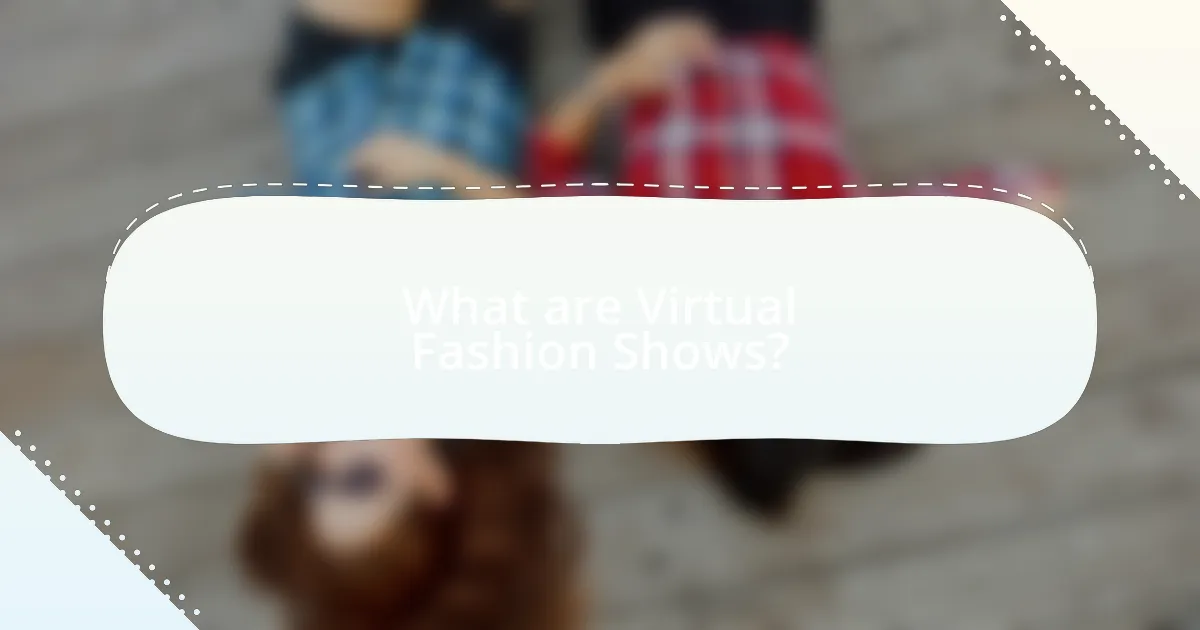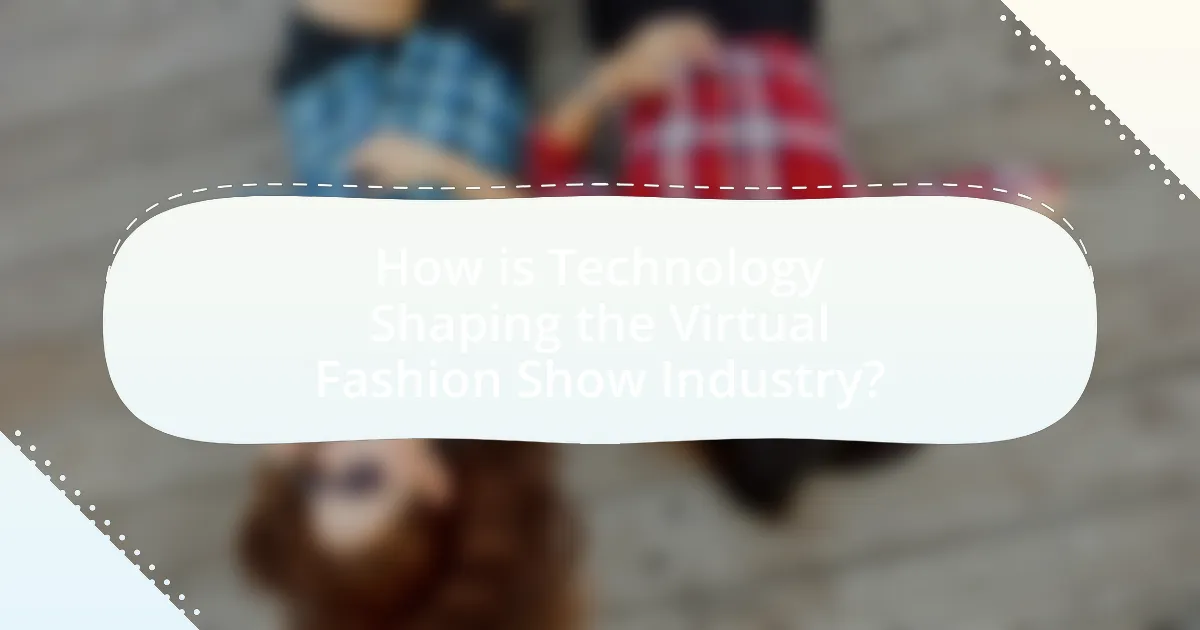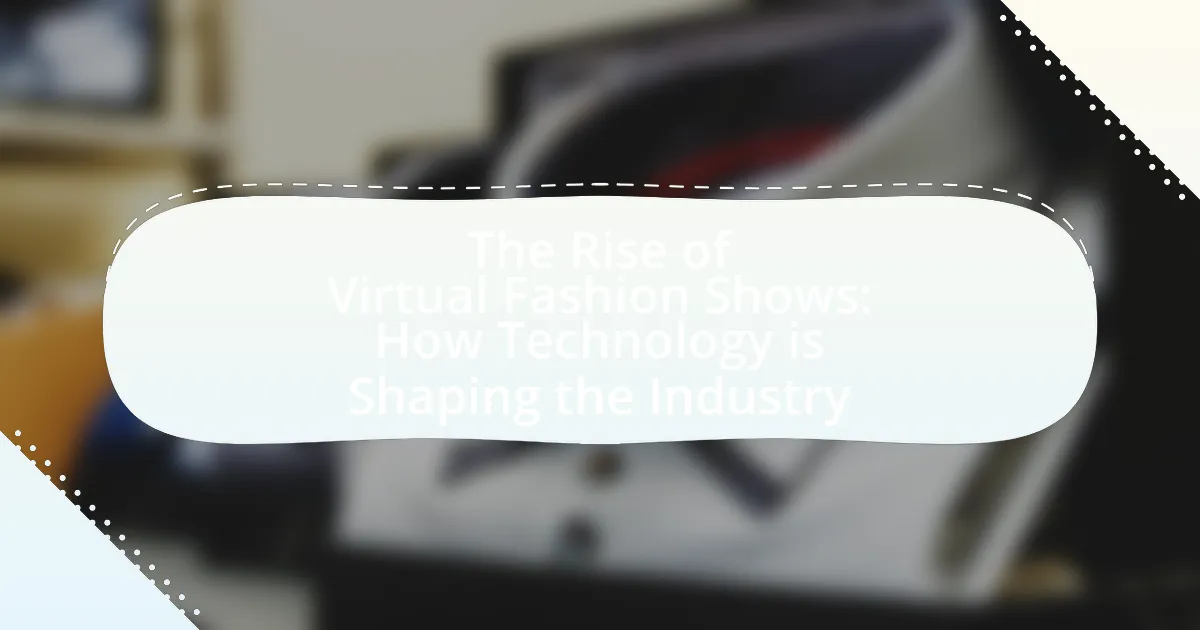Virtual fashion shows are digital presentations that leverage technology to showcase fashion collections to a global audience, utilizing tools such as augmented reality, virtual reality, and live streaming. This format differs from traditional fashion shows by offering broader accessibility and engagement, particularly highlighted during the COVID-19 pandemic when many brands transitioned to virtual platforms. The article explores the technologies driving this trend, the impact of social media, audience engagement strategies, and the challenges faced in the virtual environment. Additionally, it discusses future trends, including the role of artificial intelligence and data analytics in shaping the virtual fashion landscape.

What are Virtual Fashion Shows?
Virtual fashion shows are digital presentations of fashion collections that utilize technology to showcase designs to a global audience. These events often feature 3D models, augmented reality, and live-streaming capabilities, allowing brands to reach consumers without the limitations of physical venues. The rise of virtual fashion shows has been accelerated by advancements in technology and the need for brands to adapt to changing consumer behaviors, particularly during the COVID-19 pandemic, which restricted traditional in-person events. According to a report by McKinsey & Company, the fashion industry saw a significant shift towards digital platforms, with virtual shows becoming a key strategy for engagement and marketing.
How do Virtual Fashion Shows differ from Traditional Fashion Shows?
Virtual fashion shows differ from traditional fashion shows primarily in their format and accessibility. Traditional fashion shows occur in physical venues, often limited to a select audience, while virtual fashion shows utilize digital platforms, allowing global access to viewers. This shift has been accelerated by advancements in technology, enabling brands to reach wider audiences without geographical constraints. For instance, during the COVID-19 pandemic, many designers transitioned to virtual formats, showcasing collections through live streams and pre-recorded videos, which resulted in increased viewer engagement and participation.
What technologies are utilized in Virtual Fashion Shows?
Virtual fashion shows utilize technologies such as augmented reality (AR), virtual reality (VR), 3D modeling, and live streaming. AR enhances the viewer’s experience by overlaying digital elements onto the real world, allowing for interactive presentations. VR creates immersive environments where audiences can engage with fashion in a fully virtual space. 3D modeling enables designers to create realistic digital garments and runway settings, facilitating innovative designs without physical limitations. Live streaming technology allows these shows to reach global audiences in real-time, increasing accessibility and engagement. These technologies collectively transform the traditional fashion show format, making it more interactive and widely available.
How do audience engagement strategies vary between the two formats?
Audience engagement strategies differ significantly between traditional fashion shows and virtual fashion shows. Traditional fashion shows often rely on in-person attendance, creating an exclusive atmosphere that engages audiences through direct interaction, live performances, and immediate feedback from attendees. In contrast, virtual fashion shows utilize digital platforms to reach a broader audience, employing interactive elements such as live chats, social media integration, and gamification to enhance viewer participation. For instance, a study by McKinsey & Company in 2021 highlighted that virtual events can attract up to 10 times more viewers than physical shows, demonstrating the effectiveness of digital engagement strategies in expanding audience reach.
Why are Virtual Fashion Shows gaining popularity?
Virtual fashion shows are gaining popularity due to their ability to reach a global audience and provide immersive experiences. The shift towards digital platforms allows brands to showcase collections without geographical limitations, significantly increasing viewer engagement. For instance, during the COVID-19 pandemic, brands like Balenciaga and Gucci successfully hosted virtual shows that attracted millions of viewers online, demonstrating the effectiveness of this format. Additionally, virtual fashion shows utilize advanced technologies such as augmented reality and 3D modeling, enhancing the visual experience and allowing for innovative storytelling. This combination of accessibility and technological integration is driving the trend of virtual fashion shows in the industry.
What role does social media play in the rise of Virtual Fashion Shows?
Social media significantly contributes to the rise of Virtual Fashion Shows by providing a platform for widespread visibility and engagement. It allows brands to reach global audiences instantly, facilitating real-time interaction and feedback from viewers. For instance, during the COVID-19 pandemic, many fashion houses transitioned to virtual formats, leveraging platforms like Instagram and TikTok to showcase their collections, which resulted in increased viewer engagement and brand loyalty. According to a report by McKinsey & Company, digital channels, including social media, have become essential for fashion brands, with 75% of consumers engaging with brands through social media during fashion events. This shift underscores the critical role social media plays in enhancing the accessibility and appeal of Virtual Fashion Shows.
How has the COVID-19 pandemic influenced the shift to Virtual Fashion Shows?
The COVID-19 pandemic has significantly accelerated the shift to Virtual Fashion Shows by necessitating remote presentations due to social distancing measures. As traditional in-person events were canceled or restricted, fashion brands turned to digital platforms to showcase their collections, leading to an increase in virtual formats. For instance, major fashion weeks, such as New York and Paris, adopted online presentations, allowing designers to reach global audiences without geographical limitations. This transition has been supported by advancements in technology, enabling high-quality streaming and interactive experiences, which have become essential for engaging consumers during lockdowns.

How is Technology Shaping the Virtual Fashion Show Industry?
Technology is significantly shaping the virtual fashion show industry by enabling immersive experiences and enhancing accessibility. Innovations such as augmented reality (AR) and virtual reality (VR) allow designers to create interactive environments where viewers can engage with fashion in a three-dimensional space. For instance, brands like Balenciaga and Gucci have utilized VR platforms to showcase their collections, reaching global audiences without the constraints of physical venues. Additionally, live streaming technology facilitates real-time participation, allowing viewers to experience shows as they happen, which has been crucial during events like the COVID-19 pandemic when traditional shows were canceled. This shift not only democratizes access to fashion but also allows for innovative storytelling and brand engagement, as evidenced by the increased viewership and social media interaction during virtual events compared to traditional formats.
What advancements in technology are driving Virtual Fashion Shows?
Advancements in technology driving Virtual Fashion Shows include augmented reality (AR), virtual reality (VR), and artificial intelligence (AI). AR enhances the viewer’s experience by allowing them to visualize clothing in real-time through their devices, while VR creates immersive environments where audiences can attend shows from anywhere in the world. AI plays a crucial role in personalizing experiences and analyzing consumer data to tailor fashion presentations. For instance, brands like Balenciaga and Gucci have successfully utilized these technologies to reach wider audiences and create engaging content, demonstrating the effectiveness of these advancements in reshaping the fashion industry.
How do augmented reality and virtual reality enhance the viewer experience?
Augmented reality (AR) and virtual reality (VR) significantly enhance the viewer experience by creating immersive environments that engage users on a deeper level. AR overlays digital information onto the real world, allowing viewers to interact with fashion items in their own space, while VR transports users into entirely virtual settings where they can experience fashion shows as if they were physically present. Research indicates that 70% of consumers feel more connected to brands that use AR and VR technologies, demonstrating their effectiveness in fostering engagement and emotional connection. This immersive interaction not only captivates viewers but also allows for personalized experiences, such as trying on clothes virtually, which can lead to increased satisfaction and purchasing intent.
What impact do live streaming platforms have on Virtual Fashion Shows?
Live streaming platforms significantly enhance the reach and accessibility of Virtual Fashion Shows. By enabling real-time broadcasting, these platforms allow designers to showcase their collections to a global audience, breaking geographical barriers that traditional fashion shows face. For instance, during the COVID-19 pandemic, brands like Balenciaga and Gucci utilized live streaming to engage millions of viewers, demonstrating that such platforms can attract larger audiences than physical events. This shift not only democratizes fashion but also provides valuable data on viewer engagement and preferences, which can inform future marketing strategies.
What challenges does technology present for Virtual Fashion Shows?
Technology presents several challenges for Virtual Fashion Shows, including issues related to accessibility, technical reliability, and audience engagement. Accessibility can be hindered by varying internet speeds and device compatibility, which may prevent some viewers from experiencing the show fully. Technical reliability is crucial, as glitches or crashes during a live stream can disrupt the presentation and diminish the overall impact. Additionally, engaging an audience in a virtual format poses difficulties, as the lack of physical presence can reduce the emotional connection and excitement typically felt in traditional fashion shows. These challenges highlight the need for robust technological solutions to enhance the virtual experience and ensure inclusivity.
How do technical difficulties affect the audience’s perception?
Technical difficulties negatively impact the audience’s perception by creating distractions and diminishing the overall experience. When issues such as poor video quality, audio problems, or connectivity failures occur during virtual fashion shows, they can lead to frustration and disengagement among viewers. Research indicates that 70% of audiences report a decrease in satisfaction when faced with technical glitches, which can ultimately affect their perception of the brand and the event itself. This correlation highlights the importance of seamless technology in maintaining audience engagement and positive impressions in the context of virtual fashion shows.
What are the security concerns associated with Virtual Fashion Shows?
Security concerns associated with Virtual Fashion Shows include data breaches, unauthorized access to proprietary designs, and potential cyberattacks on streaming platforms. Data breaches can expose sensitive information about brands and consumers, as evidenced by incidents where fashion companies have faced significant financial losses due to compromised customer data. Unauthorized access to proprietary designs can lead to intellectual property theft, undermining the competitive advantage of fashion brands. Additionally, cyberattacks on streaming platforms can disrupt live events, as seen in various high-profile cases where hackers targeted online events, causing reputational damage and financial repercussions for the organizers.

What are the Future Trends in Virtual Fashion Shows?
Future trends in virtual fashion shows include increased use of augmented reality (AR) and virtual reality (VR) technologies, which enhance viewer engagement by allowing immersive experiences. Brands are likely to adopt more interactive formats, enabling real-time audience participation and feedback during shows. Additionally, the integration of artificial intelligence (AI) for personalized content delivery will become prevalent, tailoring experiences to individual viewer preferences. Data from the Global Fashion Agenda indicates that the virtual fashion market is expected to grow significantly, with a projected increase in investment in digital platforms and technologies, reflecting the industry’s shift towards sustainability and inclusivity.
How will Artificial Intelligence influence future Virtual Fashion Shows?
Artificial Intelligence will significantly enhance future Virtual Fashion Shows by enabling personalized experiences and optimizing design processes. AI algorithms can analyze consumer preferences and trends, allowing brands to tailor their collections to specific audiences, thereby increasing engagement and sales. For instance, AI-driven tools like predictive analytics can forecast fashion trends based on social media data, helping designers create relevant collections. Additionally, AI can streamline production by automating tasks such as pattern making and fabric selection, reducing time and costs associated with traditional fashion design. This integration of AI not only improves efficiency but also fosters innovation in virtual environments, making fashion shows more interactive and immersive for viewers.
What role will data analytics play in shaping fashion trends?
Data analytics will play a crucial role in shaping fashion trends by enabling brands to analyze consumer behavior and preferences in real-time. This analytical capability allows fashion companies to identify emerging trends, optimize inventory management, and tailor marketing strategies to specific demographics. For instance, a report by McKinsey & Company highlights that data-driven insights can lead to a 10-20% increase in sales by aligning product offerings with consumer demand. Additionally, platforms like Google Trends provide valuable data on search patterns, helping brands anticipate shifts in consumer interests and adapt their collections accordingly.
How might personalization change the Virtual Fashion Show experience?
Personalization can significantly enhance the Virtual Fashion Show experience by tailoring content to individual preferences and behaviors. This customization allows viewers to engage with fashion shows that reflect their unique tastes, such as selecting specific designers, styles, or themes that resonate with them. Research indicates that personalized experiences can increase viewer engagement by up to 80%, as consumers are more likely to connect with content that feels relevant to them. By leveraging data analytics and AI, virtual fashion shows can create dynamic environments where users receive recommendations and interactive features, ultimately transforming passive viewing into an immersive, personalized journey.
What best practices should brands follow for successful Virtual Fashion Shows?
Brands should prioritize high-quality production and engaging storytelling for successful Virtual Fashion Shows. High-quality production involves using professional lighting, sound, and camera work to create a visually appealing experience that captures the audience’s attention. Engaging storytelling connects the audience emotionally to the brand and its collection, enhancing viewer retention and interest. According to a study by McKinsey & Company, brands that effectively engage their audience through narrative and visual elements see a 30% increase in viewer engagement compared to those that do not. Additionally, leveraging social media platforms for promotion and interaction can significantly expand reach and foster community engagement, as evidenced by the success of brands like Balenciaga and Gucci, which have effectively utilized platforms like Instagram and TikTok to enhance their virtual shows.
How can brands effectively market their Virtual Fashion Shows?
Brands can effectively market their Virtual Fashion Shows by leveraging social media platforms, influencer partnerships, and interactive content. Social media allows brands to reach a broad audience quickly; for instance, platforms like Instagram and TikTok have proven effective for fashion marketing, with 54% of users expressing interest in purchasing products seen on these platforms. Collaborating with influencers can amplify reach and credibility, as influencers often have dedicated followings that trust their recommendations. Additionally, incorporating interactive elements such as live Q&A sessions, polls, and augmented reality features can enhance viewer engagement, making the experience more immersive. These strategies collectively increase visibility and consumer interest, driving attendance and participation in Virtual Fashion Shows.
What strategies can enhance viewer engagement during Virtual Fashion Shows?
Interactive elements such as live polls, Q&A sessions, and social media integration can significantly enhance viewer engagement during Virtual Fashion Shows. These strategies allow viewers to participate actively, fostering a sense of community and involvement. For instance, incorporating live polls can provide immediate feedback on designs, while Q&A sessions enable direct interaction with designers, creating a more immersive experience. Additionally, leveraging social media platforms for real-time commentary and sharing can amplify audience reach and engagement, as evidenced by the success of brands like Balenciaga and Gucci, which have effectively utilized these tactics in their virtual presentations.

Leave a Reply